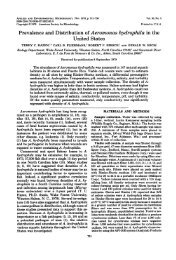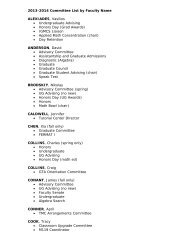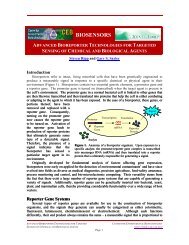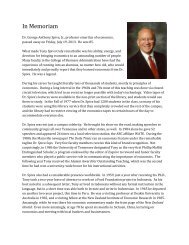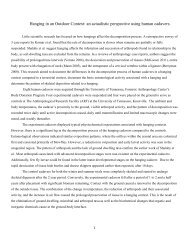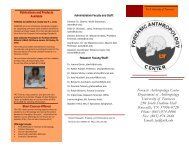variation. Separation <strong>from</strong> other <strong>Africa</strong>n taxa includes: 1) large, ellipsoid to <strong>sub</strong>amygdaliform spores; 2) 4-spored basidia; 3) deep olive color <strong>of</strong> pileus; 4) minutely roughened to farinose texture <strong>of</strong> pileus; 5) mammilate, welldeveloped cheilocystidia; and 6) unexpanded pseudorhiza. In spite <strong>of</strong> pigmented cheilocystidia, lamellae are non-marginate. Caulocystidia <strong>from</strong> stipe apex are reminiscent <strong>of</strong> cheilocystidia; well-developed, significantly inflated, hyaline and clamped. Specimen examined: NIGERIA, Cross River State, Obudu Ranch, 29.IV.1990, coll RA Nicholson (as O. radicata var. africana), Nicholson 400 [K(M) 16682]. 6. <strong>Xerula</strong> semiglabripes R.H. Petersen, sp. nov. (Figs 30-35) MycoBank: 511156 Basidiomata collybioidea, gracilis, radicata. Pileo 40-60 mm lato, convexo, vix umbonato, atrobrunneo, extra brunneo, levis; margine levi. Lamellis albis, <strong>sub</strong>ventricosis, adnatis, non-marginatis. Stipite 80-100 × 2 mm, apice pallidis, deorsum brunneis, glabris; pseudorhiza inflata, radicata. Pileocystidiis 24-42 × 10-26 µm, sphaeropedunculatis, fibulatis, olivaceo-brunneis. Pleurocystidiis 85- 141 × 20-38 µm, pedicellatis, fusiformis ad fusiformis<strong>sub</strong>capitulatis, hyalinis, tenuitunicatis, fibulatis. Basidiis 46-58 × 13-18 µm, clavatis ad urniformis, tetra-sporis, fibulatis. Basidiosporis 13-17.5 × 10.5-13 µm (E m = 1.38; L m = 15.3 µm), ellipsoideis. Cheilocystidiis 33-100 × 10-30 µm, pedicellatis, clavatis ad late fusiformis. Caulocystidiis 31-77× 11-16 µm, clavatis ad cylindricis, hyalinis, firme tunicatis, fibulatis. Holotype: KENYA, Central Prov., Kiambu Dist., Muguga (EAAFRO), 13.III.1968, coll DN Pegler (K47, as O. radicata var. africana) [K(M) 129460] [annot. H. Dörfelt, as X. radicata]. Basidiome (Fig. 30) collybioid, gracile, rooting. Pileus 40-60 mm broad, shallowly convex with low, gradual umbo, dark brown over disc ("Saccardo's umber"), somewhat lighter over limb and margin (darker than "sayal brown"), smooth, not laccate; margin thin, inrolled. Lamellae adnate with little evidence <strong>of</strong> decurrent tooh, white when fresh, after drying light ochraceous buff, not marginate (but in dried specimens margin appearing hygrophanous, cartilaginous and somewhat darker than lamellar face), hardly ventricose, in three ranks. Stipe 80-100 mm long to ground line, 2 mm broad in midsection; apex pallid, flaired, minutely silky but not ornamented; mid-stipe brown, glabrous with no sign <strong>of</strong> caulocystidia (25×); pseudorhizal swelling seven mm broad, brown; pseudorhizal extension involved in clay soil, brown, glabrous (not with normal pallid tomentum). Fig. 30. <strong>Xerula</strong> semiglabripes; (<strong>from</strong> holotype). Basidioma (illustrative reconstruction). Bar = 40 mm. Pileipellis constructed <strong>of</strong> a single element. Pileocystidia (Fig. 31) <strong>from</strong> near pileus margin 24-42 × 10-26 µm, pedicellate (usually short), sphaeropedunculate, occasionally clavate, obscurely clamped, thin-walled; contents coagulated olive-tan, homogeneous. Pleurocystidia (Fig. 32) 85-141 × 20-38 µm, broadly jar-shaped, fusiform-capitulate to broadly fusiform-capitulate, hyaline, thinwalled, clamped; contents homogeneous, <strong>sub</strong>refringent in capitulum. Basidia (Fig. 33) 46-58 × 13-18 µm, clavate to urniform-clavate <strong>from</strong> pinched base, 4-spored, obscurely clamped; sterigmata weak and small for this genus; contents axially sludgy. Basidiospores (Fig. 33) 13-17.5 × 10.5-13 µm (E = 1.17-1.59; E m = 1.38; L m = 15.3 µm), ellipsoid (not <strong>sub</strong>limoniform), smooth to delicately dimpled, flattened adaxially; contents uniguttulate when mature. Lamellar margin sterile, hardly extended in KOH, appearing as though repent (100×), a solid palisade <strong>of</strong> cheilocystidia. Cheilocystidia (Fig. 34) 33-100 × 10-30 µm, 138
Fungal Diversity Figs 31-34. <strong>Xerula</strong> semiglabripes. 31. Pileipellis elements. Holotype. 32. Pleurocystidia. Holotype. 33. Basidia and basidiospores. Basidia and lower basidiospores, Pegler K112. Upper basidiospores, holotype. 34. Cheilocystidia, Pegler K112. Bars = 20 µm. clavate to broadly fusiform, <strong>of</strong>ten with suggestion <strong>of</strong> capitulum in smaller individuals, thin-walled, hyaline, inconspicuously clamped; contents homogeneous. Stipe apex s<strong>of</strong>t, silky, with no evidence <strong>of</strong> caulocystidia. Apical caulocystidia represented by an arachnoid layer <strong>of</strong> slender (1.5-3 µm diam), thin-walled, hyaline hyphae with rare inflated (-18 µm diam) termini curling outward (semi-erect). Stipe midsection with somewhat more complex arachnoid layer, commonly gathered in sori <strong>of</strong> caulocystidial termini; caulocystidia (Fig. 35) 31-77 × 11-16 µm (usually on the short side), pedicellate with slender base, clavate to <strong>sub</strong>cylindrical, hyaline, firm-walled (wall never more than 0.7 µm thick), inconspicuously clamped; contents homogeneous. 139





